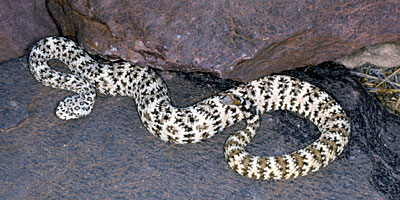![[Ocean Oasis Field Guide]](images/bnr-oo-field.gif)

![[Ocean Oasis Field Guide]](images/bnr-oo-field.gif) |  |
|
Crotalus mitchelli VIPERIDAE
Crotalus comes from the Greek crotalon, a rattle or little bell. The name mitchelli is in honor of S. W. Mitchell, a medical doctor interested in rattlesnake venom. Many references will spell mitchelli with two ii, as in mitchellii. DescriptionMost adult Speckled Rattlesnakes measure 24 to 30 inches in length. Some "giants" measuring almost 36 inches have been found. This species varies in color, often matching the earth tones of the rocks and soil it inhabits. Some occur in beautiful shades of orange or pink. Black speckles form indistinct cross bars or dorsal blotches across the back. Some desert specimens are colored like decomposed granite. Dark rings encircle the tail. SubspeciesThere are three subspecies: the San Lucan Speckled Rattlesnake (C. m. mitchelli); the Panamint Speckled Rattlesnake (C. m. stephensi); and the Southwestern Speckled Rattlesnake (C. v. pyrrhus). All appear to intergrade widely. Range and HabitatThe Speckled Rattlesnake ranges from southern Nevada to the Cape region of Baja California Sur, and east to central Arizona and extreme northern Sonora, Mexico. This distribution mirrors the combined Mojave and Sonoran Deserts. In southern California, this species is more abundant in rocky habitats, inland from the coast. It also inhabits rocky hillsides and alluvial deposits in the desert. The Speckled Rattlesnake is not often seen in coastal areas. Natural HistoryLike many other snakes, this species tends to be diurnal in cool weather, and nocturnal during hot weather. Speckled rattlers are alert and often quick to rattle when disturbed. Prey consists of small mammals, lizards, and occasionally birds. Mating occurs in spring, and 3 to 11 live young are born in late summer. 
Conservation StatusThere are no proposed conservation plans. Because of widespread negative attitudes towards snakes, very few conservation programs, worldwide, have been created. A much higher percentage of snakes are threatened with extinction than is currently recognized. Therefore, snakes are particularly suspectible to being overlooked by conservation-minded biologists. |
Text by Jim Melli
Photos by Bradford Hollingsworth
Field Guide |
Site Index |
Ocean Oasis Introduction
|
|
© 2000 San Diego Natural History Museum |